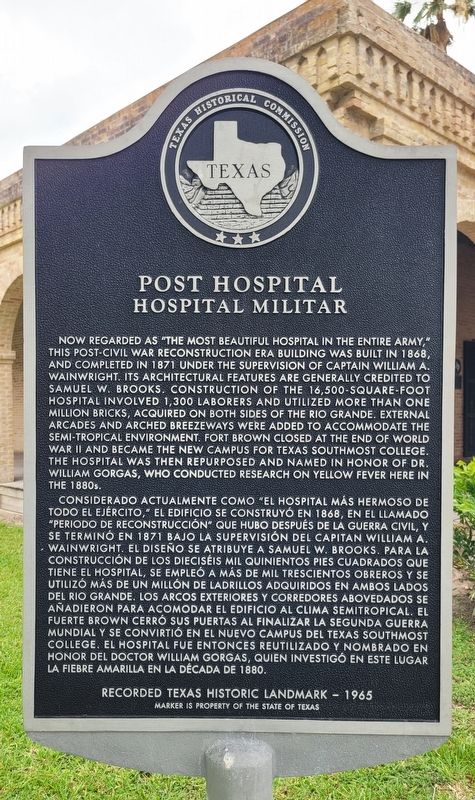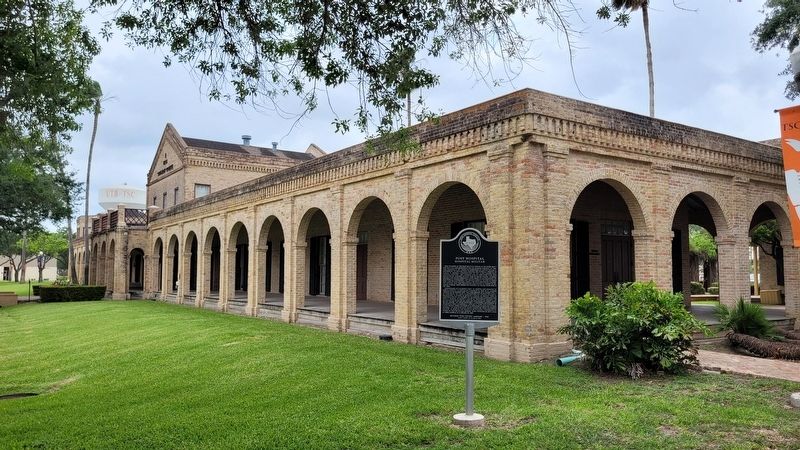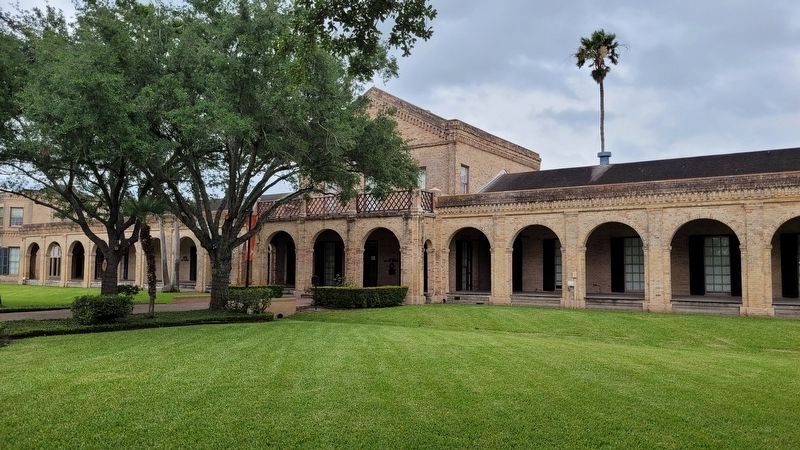Brownsville in Cameron County, Texas — The American South (West South Central)
Post Hospital / Hospital Militar
Spanish:
Erected 1965 by Texas Historical Commission.
Topics. This historical marker is listed in these topic lists: Forts and Castles • Science & Medicine. A significant historical year for this entry is 1868.
Location. 25° 53.914′ N, 97° 29.555′ W. Marker is in Brownsville, Texas, in Cameron County. Marker is at the intersection of May Street and Taylor Avenue, on the left when traveling south on May Street. The marker is located west of the Texas Southmost College-Gorgas building on the campus of Texas Southmost College. Touch for map. Marker is at or near this postal address: 60 May St, Brownsville TX 78520, United States of America. Touch for directions.
Other nearby markers. At least 8 other markers are within walking distance of this marker. Post Hospital (a few steps from this marker); Commandant's Quarters
(a few steps from this marker); Post Hospital Annex (within shouting distance of this marker); Fort Brown Reservation (within shouting distance of this marker); Launching Site of First U.S. Army Warplane (within shouting distance of this marker); a different marker also named Post Hospital (within shouting distance of this marker); a different marker also named Post Hospital Annex (within shouting distance of this marker); a different marker also named Post Hospital (within shouting distance of this marker). Touch for a list and map of all markers in Brownsville.
More about this marker. The historic Fort Brown buildings are located around the campus of the Texas Southmost College and they are currently used with the college.
Also see . . . Fort Brown. Texas State Historical Association (TSHA)
Fort Brown, originally called Fort Texas, was established when Zachary Taylor and the United States forces of occupation arrived on the Rio Grande on March 26, 1846, to establish the river as the southern boundary of Texas. In April 1846 Taylor built an earthen fort of 800 yards perimeter, with six bastions, walls more than nine feet high, a parapet of fifteen feet, and the whole surrounded by a ditch fifteen feet deep and twenty feet wide. Armament was four eighteen-pound guns. The Seventh Infantry, with Company I of the Second Artillery and Company E, Third Artillery, commanded by Maj. Jacob Brown, garrisoned the fort. Mexican troops led by Mariano Arista intercepted United States troops as they brought supplies from Fort Polk at Point Isabel to Fort Brown, leading to the opening battles of the war, Palo Alto and Resaca de la Palma, fought on May 8 and 9, 1846. On May 9 Major Brown died from injuries received during the bombardment of the fort by Mexican forces in Matamoros. Shortly after his death he was buried within the fortifications, and the post was named in his honor.(Submitted on May 12, 2023, by James Hulse of Medina, Texas.)
Credits. This page was last revised on May 12, 2023. It was originally submitted on May 10, 2023, by James Hulse of Medina, Texas. This page has been viewed 81 times since then and 30 times this year. Photos: 1, 2, 3. submitted on May 12, 2023, by James Hulse of Medina, Texas.


